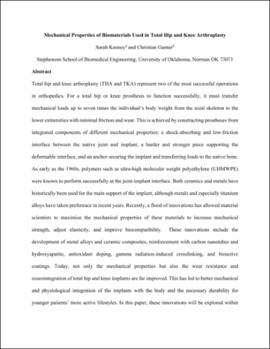| dc.description.abstract | Total hip and knee arthroplasty (THA and TKA) represent two of the most successful operations in orthopedics. For a total hip or knee prosthesis to function successfully, it must transfer mechanical loads up to seven times the individual’s body weight from the axial skeleton to the lower extremities with minimal friction and wear. This is achieved by constructing prostheses from integrated components of different mechanical properties: a shock-absorbing and low-friction interface between the native joint and implant; a harder and stronger piece supporting the deformable interface, and an anchor securing the implant and transferring loads to the native bone. As early as the 1960s, polymers such as ultra-high molecular weight polyethylene (UHMWPE) were known to perform successfully at the joint-implant interface. Both ceramics and metals have historically been used for the main support of the implant, although metals and especially titanium alloys have taken preference in recent years. Recently, a flood of innovations has allowed material scientists to maximize the mechanical properties of these materials to increase mechanical strength, adjust elasticity, and improve biocompatibility. These innovations include the development of metal alloys and ceramic composites, reinforcement with carbon nanotubes and hydroxyapatite, antioxidant doping, gamma radiation-induced crosslinking, and bioactive coatings. Today, not only the mechanical properties but also the wear resistance and osseointegration of total hip and knee implants are far improved. This has led to better mechanical and physiological integration of the implants with the body and the necessary durability for younger patients’ more active lifestyles. In this paper, these innovations will be explored within the framework of implant mechanics to provide a comparative assessment of current materials’ mechanical capabilities, advantages, and disadvantages. | en_US |



